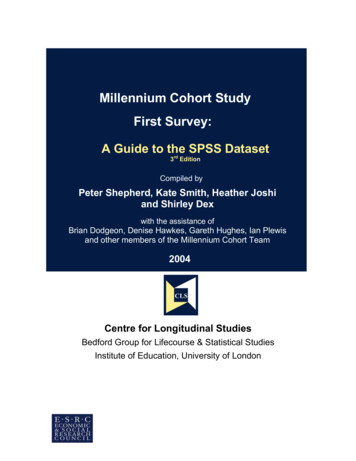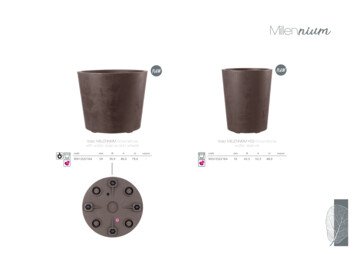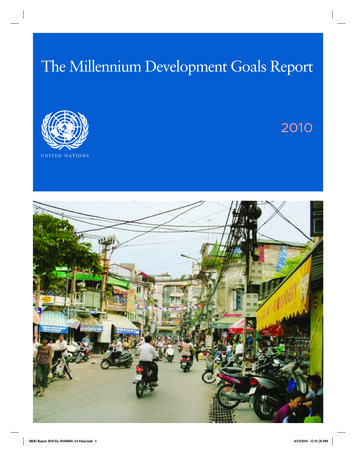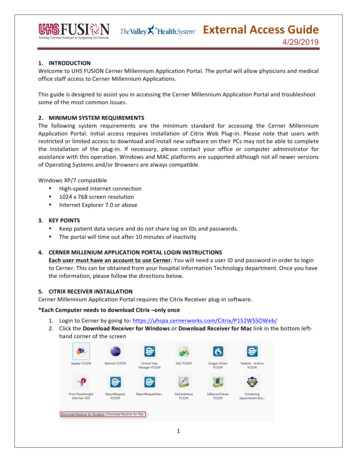
Transcription
INDICATORS for Monitoring the Millennium Development GoalsDefinitionsRationaleConceptsand SourcesUnited Nations
ST/ESA/STAT/SER.F/95United Nations Development GroupLed byUnited Nations Population FundUnited Nations Development ProgrammeDepartment of Economic andSocial Affairs–Statistics DivisionIndicators for Monitoring theMillennium Development GoalsDefinitions Rationale Concepts and SourcesUnited NationsNew York2003
Indicators for Monitoring the Millennium Development GoalsNOTEThe designations employed and the presentation of material in this publication donot imply the expression of any opinion whatsoever on the part of the United Nationsconcerning the legal status of any country, territory, city or area or of its authorities,or concerning the delimitation of its frontiers or boundaries. The term “country” asused in the text of this report refers, as appropriate, to territories or areas. The designations of “developed”. “developing” and “least developed” countries are intendedfor convenience and do not necessarily express a judgement about the stage reachedby a particular country or area in the development process. Reference to “dollars” ( )indicates United States dollars, unless otherwise stated.ST/ESA/STAT/SER.F/95United Nations PublicationSales No. E.03.XVII. 18ISBN 92-1-161467-8Copyright United Nations 2003All rights reservedGraphic design and Desktop composition Andy Musilliii
Definitions, Rationale, Concepts and SourcesFOREWORDBuilding on the United Nations global conferences of the 1990s, the United NationsMillennium Declaration of 2000 marked a strong commitment to the right to development, to peace and security, to gender equality, to the eradication of the manydimensions of poverty and to sustainable human development. Embedded in thatDeclaration, which was adopted by 147 heads of State and 189 states, were whathave become known as the eight Millennium Development Goals, including 18 timebound targets.To monitor progress towards the goals and targets, the United Nations system,including the World Bank and the International Monetary Fund, as well as theDevelopment Assistance Committee of the Organisation for Economic Co-operationand Development, came together under the Office of the Secretary-General andagreed on 48 quantitative indicators. The indicators built upon an intergovernmental process to identify relevant indicators in response to global conferences. TheSecretary-General presented the goals, targets and indicators to the GeneralAssembly in September 2001 in his report entitled “Road map towards the implementation of the United Nations Millennium Declaration”.The present handbook provides guidance on the definitions, rationale, concepts andsources of data for each of the indicators that are being used to monitor the goals andtargets. It expands on an earlier exercise to provide the metadata for the socio-economic indicators that make up the United Nations Common Country AssessmentIndicator Framework. The indicators for goals 1–7 are a subset of that framework.Preparation of the handbook was directed by an inter-agency working group of theUnited Nations Development Group, including the World Bank, chaired by the UnitedNations Population Fund and co-chaired by the United Nations Statistics Division andthe United Nations Development Programme. On behalf of the United NationsDevelopment Group, I would like to thank all the agencies and individuals (see below)who contributed to this handbook, including the Department for InternationalDevelopment of the Government of the United Kingdom, which funded the servicesof a short-term consultant who contributed to the handbook.I believe that this tangible example of interagency collaboration will prove useful tothe international community by strengthening national statistical capacity andimproving monitoring. And I sincerely hope that this will be sustained through futurerevisions in the same spirit.Mark Malloch BrownChairmanUnited Nations Development GroupSeptember 2003iii
Definitions, Rationale, Concepts and ments.Introduction.Goals,targetsandindicators.1. . Proportionof populationbelow 1. ntratio(percentageof populationbelowthe. nationalpovertyline).2. . y).3. . Shareof poorestquintileinnationalconsumption.4. . Prevalenceof .underweightchildrenunder5 yearsof. age. . . . . . . .5. . Proportionof populationbelowminimumlevelof. dietaryenergyconsumption.6. . Net. enrolmentratioinprimaryeducation.7. . Proportionof pupilsstartinggrade1 .who. reachgrade5. . . . . . . .7A.Primarycompletionrate.8. . Literacyrateof15–24year-olds.9. . ucation.10.Ratioofliteratewomento. men,15–24yearsold. . . . . . . . . .11.Shareof womenin. wageemploymentin yrate.14.Infantmortalityrate.15.Proportionof killedhealthpersonnel.18.HIV. ndomuserateofthecontraceptiveprevalencerate.19A. Condom use at last high-risk sex . . . . . . . . . . . . . .19B. Percentage of population aged 15–24 years with comprehensive correct knowledgeof .HIV/AIDS.19C.Contraceptiveprevalencerate. . . . . . . . . . . . . . .20. Ratio of school attendance of orphans to school attendance of atesassociatedwithmalaria.22. Proportion of population in malaria-risk areas using effective malariapreventionand. atedwithtuberculosis.24. Proportion of tuberculosis cases detected and cured under DOTS25. Proportion. of land. area. covered. by. forest.26.ofprotected. Ratio. area. to. maintain. biological. diversity. to. surface. area.27.Energyuse(kilogramoilequivalent)per 1grossdomesticproduct(PPP).28.and. Carbon. dioxide. emissions.per . capita.consumption. of. ozone-depleting.chlorofluorocarbons (ODP tons)29.populationusing. Proportion. of the. solid. fuels.30.with. Proportion. of population. sustainable. access. to an. improved. water.source, urban and rural.31.Proportionwithand. of population. access.to improved. sanitation,. 0323436394042444546484951535456585961636466v
Indicators for Monitoring the Millennium Development Goals.viProportionof. householdswithaccessto. ountries,as. a percentageofOECD/DACdonors’gross.national cableODAofOECD/DACdonorstobasicsocial.services (basic education, primary health care, nutrition, safe water and 7. . ODAreceivedin .smallislanddevelopingStatesas a. proportionof .developing countries and from the least developed countries, admitted free of duty76.39. . Averagetariffsimposedby developedcountrieson. agriculturalproductsand.clothing from developing y81.42. Total number of countries that have reached their HIPC decision pointsandnumberthat. ,eachsexandtotal86.46. Proportion of population with access to affordable essential drugs on bscribersper100population89.48. . Personalcomputersin erage15whoareworking93.CCA.30. . Employmentto efloorareaperperson97.CCA.43. . Numberofintentionalhomicidesper. ernationaldatasources100.Annex3. Websites. (seealsoreferencesin. the. es106.32. .33. .
Definitions, Rationale, Concepts and SourcesA B B R E V I AT I O N SA, C, E, F, R, NPHBSHIPCICESILOIMFIPUISCED TCBDBTRAINSUN-HABITATUNAIDSUNDPUNESCOTranslated publications available in Arabic, Chinese, English,French, Russian and Spanish, at http://unstats.un.org.unsd/pubs/common country assessmentchlorofluorocarbonscost, insurance and freightCore Welfare Indicators Questionnaire in AfricaDevelopment Assistance Committee of the OECDDemographic and Health Surveyinternationally recommended tuberculosis control strategydiphtheria, pertussis and tetanus vaccineExpanded Programme on ImmunizationFood and Agriculture Organization of the United Nationsfree on boardgross domestic productgross national incomegross national producthousehold budget surveyHeavily Indebted Poor Countries Initiativeincome, consumption and expenditure surveyInternatonal Labour OrganizationInternational Monetary FundInter-Parliamentary UnionInternational Standard Classification of Education, 1997 versionInternational Standard Industrial Classification of All EconomicActivitiesInternational Telecommunication UnionInternational Union for Conservation of Nature and NaturalResources–The World Conservation Unionkilogramleast developed countrieslabour force surveysLiving Standards Measurement StudyMultiple Indicator Cluster SurveyNational Center for Health Statisticsofficial development assistanceozone-depleting potentialOrganisation for Economic Co-operation and Developmentpersonal computerspurchasing power paritytrade capacity-building databaseTrade Analysis and Information SystemUnited Nations Human Settlements ProgrammeJoint United Nations Programme on HIV/AIDSUnited Nations Development ProgrammeUnited Nations Educational, Scientific and Cultural Organizationvii
Indicators for Monitoring the Millennium Development GoalsMEMBERS AND CONTRIBUTORS TO THE UNITED NATIONSDEVELOPMENT GROUP WORKING GROUP ON INDICATORSUnited Nations Population FundRichard Leete, ChairIqbal AlamKourtoum NacroMickie SchochDepartment of Economic and SocialAffairs Statistics DivisionStefan Schweinfest, Vice ChairRobert JohnstonGiselle KamanouFrancesca PerucciUnited Nations Development ProgrammeDiana Alarcon, Vice ChairJan VandemoorteleHaishan FuUnited Nations Development Group OfficeGerton van den AkkerAlain NickelsHeidi SwindellsTom Griffin (consultant)Executive Office of the Secretary-GeneralMadhushree DasguptaUnited Nations Office on Drugs and CrimeAndrea TresoOffice of the United Nations High Commissioner forHuman RightsGoro OnojimaJoint United Nations Programme on HIV/AIDSPeter GhysUnited Nations Children’s FundGareth JonesTessa WardlawUnited Nations Development Fund for WomenSuzette MitchellUnited Nations Environment ProgrammeStuart ChapeMarion CheatleVolodymyr DemkineEugene FosnightPhillip FoxGerald MutisyaviiiUnited Nations Human Settlements ProgrammeLaura LicchiWorld Food ProgrammePatricia KennedyFood and Agriculture Organization of theUnited NationsJorge MerniesToshiko MurataInternational Labour OrganizationSophia LawrenceInternational Telecommunication UnionEsperanza MagpantayUnited Nations Educational, Scientific andCultural OrganizationDenise LievesleyJosé PessoaWorld BankNeil FantomMakiko HarrisonEric SwansonWorld Health OrganizationChristopher MurrayCarla AbouZahrWorld Trade OrganizationGuy KarsentyUnited Nations Framework Convention onClimate ChangeJames GrabertInter-Parliamentary UnionKareen JabreOrganisation for Economic Co-operationand DevelopmentBrian HammondSimon Scott
Definitions, Rationale, Concepts and SourcesINTRODUCTIONIndicators for Monitoring the Millennium Development Goals: Definitions, Rationale,Concepts and Sources contains basic metadata on the agreed list of quantitativeindicators for monitoring progress towards the eight goals and 18 targets derivedfrom the United Nations Millennium Declaration (table). The list of indicators, developed using several criteria, is not intended to be prescriptive but to take intoaccount the country setting and the views of various stakeholders in preparingcountry-level reports.Five main criteria guided the selection of indicators. Indicators should: Provide relevant and robust measures of progress towards the targets of theMillennium Development Goals Be clear and straightforward to interpret and provide a basis for internationalcomparison Be broadly consistent with other global lists and avoid imposing an unnecessaryburden on country teams, Governments and other partners Be based to the greatest extent possible on international standards, recommendations and best practices Be constructed from well-established data sources, be quantifiable and be consistent to enable measurement over timeThe present handbook is designed to provide United Nations country teams andnational and international stakeholders with guidance on the definitions, rationale,concepts and sources of the data for the indicators that are being used to monitorthe Millennium Development Goals. Just as the indicator list is dynamic and will necessarily evolve in response to changing national situations, so will the metadatachange over time as concepts, definitions and methodologies change.A consultation process, generally involving the national statistical office or othernational authority, should be initiated in the selection and compilation of countryspecific indicators. The consultation should take into account national developmentpriorities, the suggested list of indicators and the availability of data. The UnitedNations country team should work collaboratively to help build ownership and consensus on the selected indicators.NATIONAL SOURCESCountry data should be used for compiling the indicators where such data are available and of reasonable quality. The data source for each indicator and the quantitative value of the indicator should be decided by consensus among the key stakeholders, especially the national statistical system. The national statistical systemshould own the data and related indicators.For any given indicator, a wide range of data sources may be available within thecountry, and each source should be critically reviewed. Existing data sources andreporting systems should be used where possible, particularly where line ministrieshave their own statistical systems. International data sources should be consulted1
Indicators for Monitoring the Millennium Development Goalsfor validation and in the absence of national sources.METADATA SHEETSFor each indicator used to measure progress towards the targets and goals, thehandbook provides all or some of the following information: A simple operational definition The goal and target it addresses The rationale for use of the indicator The method of computation Sources of data References, including relevant international Web sites Periodicity of measurement Gender and disaggregation issues Limitations of the indicator National and international agencies involved in the collection, compilation ordissemination of the dataThe intention is not to provide an exhaustive amount of information for each item,but to provide a reference point and guidance for country teams and national stakeholders. The amount of information varies by indicator and tends to reflect theextent of national and international debate on its relevance. Limited information isavailable for some of the less well-established indicators. With further use of theindicators and greater recognition of the need for such data, fuller information isexpected to become available.Monitoring of the Millennium Development Goals is taking place globally, throughannual reports of the United Nations Secretary-General to the General Assembly andthrough periodic country reporting. For global reporting, use is made of indicatorscompiled by international organizations. Internationally compiled indicators, basedon standard concepts, definitions and methodologies, more readily facilitate crosscountry comparisons. For country reporting, use is generally made of indicators compiled from national sources, generally by the national statistical system. The metadata sheets for the indicators reflect national and international standards.ANNEX 1 provides metadata for some additional indicators included in the commoncountry assessment indicator framework; the indicators for Millennium DevelopmentGoals 1–7 are a subset of that framework. ANNEX 2 supplies information on the household surveys and national sources mentioned in the metadata for constructing theindicators. ANNEX 3 gives the World Wide Web addresses of the agencies involved. ANNEX4 lists the major world summits and conferences that have helped to shape theMillennium Development Goals and indicators.2
Definitions, Rationale, Concepts and SourcesGoals, targets and indicatorsGOALS AND TARGETSINDICATORS FOR MONITORING PROGRESSFROM THE MILLENNIUM DECLARATIONGOAL 1: ERADICATE EXTREME POVERTY AND HUNGERTARGET 1:TARGET 2:Halve, between 1990 and 2015, the proportion of people whose income isless than one dollar a dayHalve, between 1990 and 2015, the proportion of people who suffer fromhungera2.3.Proportion of population below 1 (PPP) per dayPoverty headcount ratio (percentage of population below the national povertyline)Poverty gap ratio [incidence x depth of poverty]Share of poorest quintile in national consumption4.5.Prevalence of underweight children under 5 years of ageProportion of population below minimum level of dietary energy consumption6.7.8.Net enrolment ratio in primary educationbProportion of pupils starting grade 1 who reach grade 5Literacy rate of 15–24 year-olds9.10.11.12.Ratio of girls to boys in primary, secondary and tertiary educationRatio of literate women to men, 15–24 years oldShare of women in wage employment in the non-agricultural sectorProportion of seats held by women in national parliament13.14.15.Under-five mortality rateInfant mortality rateProportion of 1 year-old children immunized against measles16.17.Maternal mortality ratioProportion of births attended by skilled health personnel1.1A.GOAL 2: ACHIEVE UNIVERSAL PRIMARY EDUCATIONTARGET 3:Ensure that, by 2015, children everywhere, boys and girls alike, will be ableto complete a full course of primary schoolingGOAL 3: PROMOTE GENDER EQUALITY AND EMPOWER WOMENTARGET 4 :Eliminate gender disparity in primary and secondary education, preferablyby 2005, and in all levels of education no later than 2015GOAL 4: REDUCE CHILD MORTALITYTARGET 5 :Reduce by two thirds, between 1990 and 2015, the under-five mortality rateGOAL 5: IMPROVE MATERNAL HEALTHTARGET 6 :Reduce by three quarters, between 1990 and 2015, the maternalmortality ratioGOAL 6: COMBAT HIV/AIDS, MALARIA AND OTHER DISEASESHIV prevalence among pregnant women aged 15–24 yearscCondom use rate of the contraceptive prevalence rateCondom use at last high-risk sexPercentage of population aged 15-24 years with comprehensive correct knowldedge of HIV/AIDS19C. Contraceptive prevalence rate20. Ratio of school attendance of orphans to school attendance of non-orphansaged 10–14yearsTARGET 7 :Have halted by 2015 and begun to reverse the spread of HIV/AIDS18.19.19A.19B.TARGET 8 :Have halted by 2015 and begun to reverse the incidence of malaria andother major diseases21.22.23.24.Prevalence and death rates associated with malariaProportion of population in malaria-risk areas using effective malaria preventioneand treatment measuresPrevalence and death rates associated with tuberculosisProportion of tuberculosis cases detected and cured under DOTSGOAL 7: ENSURE ENVIRONMENTAL SUSTAINABILITYTARGET 9 :Integrate the principles of sustainable development into country policiesand programmes and reverse the loss of environmental resources25.26.27.28.29.TARGET 10 : Halve, by 2015, the proportion of people without sustainable access to safedrinking water and basic sanitationTARGET 11 : By 2020, to have achieved a significant improvement in the lives of at least100 million slum dwellersProportion of land area covered by forestRatio of area protected to maintain biological diversity to surface areaEnergy use (kg oil equivalent) per 1 GDP (PPP)Carbon dioxide emissions per capita and consumption of ozone-depleting CFCs(ODP tons)Proportion of population using solid fuels31.Proportion of population with sustainable access to an improved watersource, urban and ruralProportion of population with access to improved sanitation, urban and rural32.Proportion of households with access to secure tenure30.3
Indicators for Monitoring the Millennium Development GoalsGOAL 8: DEVELOP A GLOBAL PARTNERSHIP FOR DEVELOPMENTTARGET 12 : Develop further an open, rule-based, predictable, non-discriminatory trading and financial systemIncludes a commitment to good governance, development and povertyreduction – both nationally and internationallyTARGET 13 : Address the special needs of the least developed countriesIncludes: tariff and quota free access for the least developed countries’exports; enhanced programme of debt relief for heavily indebted poorcountries (HIPC) and cancellation of official bilateral debt; and more generous ODA for countries committed to poverty reductionTARGET 14 : Address the special needs of landlocked countries and small island developing States (through the Programme of Action for the SustainableDevelopment of Small Island Developing States and the outcome of thetwenty-second special session of the General Assembly)TARGET 15 : Deal comprehensively with the debt problems of developing countriesthrough national and international measures in order to make debt sustainable in the long termSome of the indicators listed below are monitored separately for the least developedcountries (LDCs), Africa, landlocked countries and small island developing States.33.34.35.36.37.38.39.40.41.Official development assistanceNet ODA, total and to the least developed countries, as a percentage of OECD/DACdonors’ gross national incomeProportion of total bilateral, sector-allocable ODA of OECD/DAC donors to basicsocial services (basic education, primary health care, nutrition, safe water andsanitation)Proportion of bilateral official development assistance of OECD/DAC donors that isuntiedODA received in landlocked countries as a proportion of their gross nationalincomesODA received in small island developing States as proportion of their gross national incomesMarket accessProportion of total developed country imports (by value and excluding arms) fromdeveloping countries and and from the least developed countries, admitted free ofdutyAverage tariffs imposed by developed countries on agricultural products and textiles and clothing from developing countriesAgricultural support estimate for OECD countries as a percentage of their grossdomestic productProportion of ODA provided to help build trade capacity43.44.Debt sustainabilityTotal number of countries that have reached their HIPC decision points and number that have reached their HIPC completion points (cumulative)Debt relief committed under HIPC InitiativeDebt service as a percentage of exports of goods and servicesTARGET 16 : In cooperation with developing countries, develop and implement strategies for decent and productive work for youth45.Unemployment rate of young people aged 15-24 years, each sex and totalTARGET 17 : In cooperation with pharmaceutical companies, provide access to affordable essential drugs in developing countries46.Proportion of population with access to affordable essential drugs on a sustainablebasisTARGET 18 : In cooperation with the private sector, make available the benefitsof new technologies, especially information and communications47. Telephone lines and cellular subscribers per 100 population48A. Personal computers in use per 100 population and Internet users per 100 population48B. Internet users per 100 population42.fTHE MILLENNIUM DEVELOPMENT GOALS and targets come from the Millennium Declaration, signed by 189 countries,including 147 heads of State and Government, in September 2000 .htm). The goals and targets are interrelated and should be seen as a whole. They represent a partnershipbetween the developed countries and the developing countries “to create an environment – at the national and globallevels alike – which is conducive to development and the elimination of poverty”.Note: Goals, targets and indicators effective 8 September 2003.a For monitoring country poverty trends, indicators based on national poverty lines should be used, where available.b An alternative indicator under development is “primary completionrate”.c Among contraceptive methods, only condoms are effective in preventing HIV transmission. Since the condom use rate is only measured among women in union, it is supplemented by an indicator oncondom use in high-risk situations (indicator 19a) and an indicatoron HIV/AIDS knowledge (indicator 19b). Indicator 19c (contraceptive prevalence rate) is also useful in tracking progress in otherhealth, gender and poverty goals.d This indicator is defined as the percentage of population aged 1524 who correctly identify the two major ways of preventing thesexual transmission of HIV (using condoms and limiting sex to onefaithful, uninfected partner), who reject the two most commonlocal misconceptions about HIV transmission, and who know that a4healthy-looking person can transmit HIV. However, since there arecurrently not a sufficient number of surveys to be able to calculatethe indicator as defined above, UNICEF, in collaboration withUNAIDS and WHO, produced two proxy indicators that representtwo components of the actual indicator. They are the following: (a)percentage of women and men 15-24 who know that a person canprotect herself from HIV infection by “consistent use of condom”;(b) percentage of women and men 15-24 who know a healthylooking person can transmit HIV.e Prevention to be measured by the percentage of children under 5sleeping under insecticide-treated bednets; treatment to be measured by percentage of children under 5 who are appropriatelytreated.f An improved measure of the target for future years is under development by the International Labour Organization.
Definitions, Rationale, Concepts and Sources1 PROPORTION OF POPULATIONBELOW 1 PURCHASING POWERPARITY(PPP) PER DAYtion) curves weighted by household size. In allcases measures of poverty to obtain Lorenzcurves are calculated from primary datasources rather than existing estimates.DEFINITIONProportion of population below 1 per day isthe percentage of the population living on lessthan 1.08 a day at 1993 international prices.The one dollar a day poverty line is comparedto consumption or income per person andincludes consumption from own productionand income in kind. This poverty line hasfixed purchasing power across countries orareas and is often called an “absolute povertyline” or measure of extreme poverty.GOAL AND TARGET ADDRESSEDGoal 1. Eradicate extreme poverty and hungerTarget 1. Halve, between 1990 and 2015, theproportion of people whose income is lessthan one dollar a dayPoverty in a country is estimated by convertingthe one dollar a day poverty line to local currency using the latest purchasing power parity(PPP) exchange rates for consumption takenfrom World Bank estimates. Local consumerprice indices are then used to adjust the international poverty line in local currency to pricesprevailing around the time of the surveys. Thisinternational poverty line is used to id
48. Personal computers in use per 100 population 90 Internet users per 100 population 91 Annex 1. Additional socio-economic common country assessment indicators 93 CCA 19. Proportion of children under age 15 who are working 93 CCA 30. Employment to population of working age ratio 94 CCA 31. Unemployment rate 95 CCA 32.










